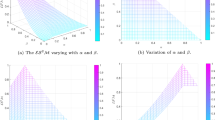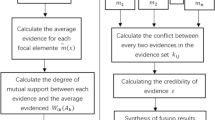Abstract
Information fusion is a very important technology which can use multisensor network data to get a better performance than single one; therefore, it is widely used in the filed of target recognition, target tracking, automatic control, decision making and so on. However, because of noise and interference, sometimes the sensors may obtain erroneous, inaccurate or heterogeneous data, which will produce the conflict information among different sensors and get the wrong result after information fusion. In this paper, based on the Dempster–Shafer (D–S) theory, we introduce how to set up the model of multisensor network information fusion. And then, we discuss the problem of conflict information fusion in the framework of evidence and several improved methods are introduced. Finally, based on Mahalanobis distance, an improved solution method is presented. The numerical simulation results prove that this new improved method can get the same result as traditional methods, beyond which it can make a reasonable decision with high conflict information. Therefore, this new improved method can be used in the filed of high noise and interference.




Similar content being viewed by others
References
Fang Z, Liyan H (2006) A survey of multisensor information fusion technology. J Telem Track command 27(3):1–7
Llinas J, Hall DL (1998) An introduction to multisensor data fusion. IEEE, pp I537–I540
Shafer G (1976) A mathematical theory of evidence. Princeton Univ. Press, Princeton
Zadeh LA (1984) Review of books: a mathematical theory of evidence. AI Mag 10(2):235–247
Yager RR (1987) On the Dempster–Shafer framework and new combination rules. Inf Sci 41:93–137
Smets P (1990) The combination of evidence in the transferable belief model. IEEE Pattern Anal Mach Intell 12(5):447–458
Dubois D, Prade H (1988) Default reasoning and possibility theory. Artif Intell 35(z):243–257
Murphy CK (2000) Combining belief functions when evidence conflicts. Decis Support Syst 29:1–9
Sun Q, Ye XQ, Gu WK (2000) A new combination rules of evidence theory. Acta Electron Sin 28(8):117–119
Li BC, Wang B, Wei J, Qian ZB, Huang YQ (2002) An efficient combination rule of evidence theory. J Data Acquis Process 17(1):33–36
Liang XR, Yao PY, Liang DL (2008) Improved combination rule of evidence theory and its application in fused target recognition. Electron Optics Control 15(12):37–41
Deng Y, Shi WK, Zhu ZF, Liu Q (2004) Combining belief functions based on distance of evidence. Decis Support Syst 38(3):489–493
Liu HY, Zhao ZG, Liu X (2008) Combination of conflict evidences in D–S theory. J Univ Electron Sci Technol China 37(5):701–704
Dempster A (1967) Upper and lower probabilities induced by multivalued mapping. Annu Math Stat 38(2):325–339
Shafer G (1976) A mathematical theory of evidence. Princeton University Press, New Jersey
Xu P, Deng Y, Su X, Mahadevan S (2013) A new method to determine basic probability assignment from training data. Knowl Based Syst 46:69–80
Jousselme AL, Grenier D, Bosse E (2001) A new distance between two bodies of evidence. Inf fusion 2(1):91–101
Wang X-X, Yang F-B (2007) A kind of evidence combination method in conflict. Danjian Yu Zhidao Xuebapo 27(8):255–257
Yong-Chao Wei (2011) An improved D–S evidence combination method based on K-L distance. Telecommun Eng 51(1):191–201
McLachlan GF (1999) Mahalanobis Distance. General articlewei, pp 20–26
Mitchell AFS, Krzanowski WJ (1985) The Mahalanobis distance and elliptic distributions. Biometrika 72(2):464–467
De Maesschalck R, Jouan-Rimbaud D, Massart DL (2000) The Mahalanobis distance[J]. Chemometrics and Intelligent Laboratory Systems, pp 1–18
Xiang S, Nie F, Zhang C (2008) Learning a Mahalanobis distance metric for data clustering and classification[J]. Pattern Recognit 41:3600–3612
Lefevre E, Colot O, Vannoorenberghe P, de Brucq D (1998) A generic framework for resolving the conflict in the combination of belief structures. In: The 3rd International Conference on Information Fusion Paris. France, pp 182–188
Yager RR (1996) On the aggregation of prioritized belief structures. IEEE Trans Syst Man Cybern Part A Syst Hum 26(6):708–717
Zhang Y, Fang K (1999) Introduction to multivariate statistical analysis. Science Press, Beijing
Acknowledgments
This work was supported by the Key Development Program of Basic Research of China (JCKY2013604B001), the Nation Nature Science Foundation of China (No. 61301095 and No. 61201237), Nature Science Foundation of Heilongjiang Province of China (No. QC2012C069, F201408 and F201407) and the Fundamental Research Funds for the Central Universities (No. HEUCF1508).
Author information
Authors and Affiliations
Corresponding author
Ethics declarations
Conflict of interest
Meantime, all the authors declare that there is no conflict of interests regarding the publication of this article.
Rights and permissions
About this article
Cite this article
Lin, Y., Wang, C., Ma, C. et al. A new combination method for multisensor conflict information. J Supercomput 72, 2874–2890 (2016). https://doi.org/10.1007/s11227-016-1681-3
Published:
Issue Date:
DOI: https://doi.org/10.1007/s11227-016-1681-3




